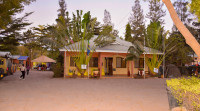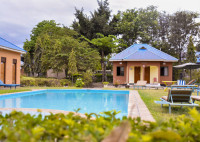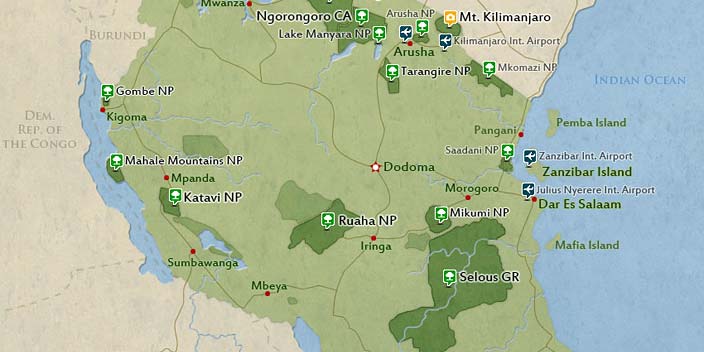
$1,724 pp (USD)
2 travelers on Start dateArrival
Arrival

Day 1
Arusha to Tarangire National Park
Arusha to Tarangire National Park
You leave Arusha after breakfast with a picnic lunch packed safely away. The Rift Valley landscape drifts past as your guide heads for Tarangire National Park, the least visited reserve on the itinerary but one capable of delivering fantastic game viewing. Home to Tanzania’s biggest elephant population, Tarangire supports large numbers of buffalo, giraffe, zebra, and many antelope species, most evident during the dry season when concentrations of animals at the life-giving Tarangire River are at their peak. You stop at a picnic site and enjoy your lunch with breath-taking views of the park’s landscape and the river below you, and maybe in the company of elephants drinking and digging water from the sand River banks, lunch proceeds with game viewing and in the late afternoon drive to your Accommodation for dinner and overnight.
- Main Destination:
- Tarangire National Park
- Accommodation:
- Fanaka Safaris, Campsites & Lodges
- Meals & Drinks:

Day 2
Exploring Lake Manyara National Park
Exploring Lake Manyara National Park
After breakfast leaves the camp and proceeds to Lake Manyara National Park for a day of game viewing an area Hemingway described as, “the loveliest I had seen in Africa”. Lake Manyara National Park is a naturalist’s delight thanks to its diverse environments. Ranging from the underground-water forest and acacia woodlands to grasslands, swamps, marshes, and hot springs, the park is simply packed with wildlife. Over 400 species of bird have been recorded including large flocks of flamingos and migratory water birds. Manyara’s forests ring with the call of monkeys and birds while its acacia woodlands are home to Manyara’s infamous tree-climbing lions and slow-strolling elephants. The park is also home to the largest troops of baboons in Africa, zebra wildebeest, giraffe, hippos, leopard, and impala, and in the late evening drive to your lodge for dinner and overnight.
- Main Destination:
- Lake Manyara National Park
- Accommodation:
- Fanaka Safaris, Campsites & Lodges
- Meals & Drinks:

Day 3
Mto wa Mbu to Serengeti National Park
Mto wa Mbu to Serengeti National Park
After a leisurely breakfast at the lodge, we set out for the endless open plains and stunning skies of Serengeti National Park – a famous migration corridor and UNESCO World Heritage site. Here, you’ll have a chance to witness the great migration of wildebeest and zebra. Depending on the time of the year, the migration is within the southern grass plains and the central part during the months of December-May. Within these two days, we will explore the park’s rich habitats for the big cats who rule the plains, Serengeti is home to lions, leopards, hippos, cheetahs, giraffes, elands, warthog, and hyrax.
The plains are dotted with mammoth rock out-crop, swamps, valleys, acacia tree lines, and River-line habitats, in the central part, marking game-viewing good throughout the year. Our campsite is set in the central park giving us perfect movement for game viewing.
- Main Destination:
- Central Serengeti National Park
- Accommodation:
- Budget camping
- Meals & Drinks:

Day 4
Exploring the Serengeti National Park
Exploring the Serengeti National Park
This entire day is set aside for game drives upon the Serengeti. The Serengeti, the habitat of an abundance of wildlife such as impala, buffalo, crocodile, and hippo, is more well-known for its great migrating herds of zebra, antelope, and wildebeest. The animals’ trek is determined by the rainfall and varies from year to year. In November and December, the animals move from the northern region, dominated by woodlands and hills, to the grassy plains of the south. During the longer rainy season from April to June, they return to the central. Apart from the migrating herds, we may have the opportunity to see the resident predators, leopard, cheetah, and lion, fulfilling their role in the circle of life.
After an unforgettable day, we will return to our carefully selected campsite for, dinner, and our overnight sleep on The Endless Plain.
- Main Destination:
- Central Serengeti National Park
- Accommodation:
- Budget camping
- Meals & Drinks:

Day 5
Serengeti to Ngorongoro Conservation Area
Serengeti to Ngorongoro Conservation Area
After an early breakfast we head out for another game drive upon the Serengeti. We may have the opportunity to spot the “Big Five” – lion, elephant, buffalo, rhino and leopard – before embarking on our journey to the Ngorongoro Crater.
The animals roam freely through the unfenced reserves offering us an uninterrupted game viewing experience.
Arriving at the edge of the crater we have our first glimpse of what awaits us the following day – glistening streams, open grassland and a myriad amount of animals.
We spend the evening and night at one of our carefully selected campsite, boasting aesthetically tasteful restaurants and the most commodious of rooms for your rest, ease, and dreams of the African Wild.
- Main Destination:
- Ngorongoro Highlands
- Accommodation:
- Budget camping
- Meals & Drinks:

Day 6
Ngorongoro Crater Tour to Arusha
Ngorongoro Crater Tour to Arusha
Leave your camp very early in the morning, and descend 610 meters down to the grasslands of the crater floor, an area of about 265 square kilometers. Despite its small size, the Crater is a Big 5 country and the openness of the terrain means easy and rewarding game viewing. You will spend the day exploring the crater floor, stopping to picnic on the grasslands amidst the grazing herds. Formed by a massive volcanic eruption, the world’s largest intact and un-flooded caldera provides a year-round home to an astonishing 25,000 large mammals including black rhino, wildebeest, and zebra along with Africa’s densest concentrations of hyena. The Crater’s forests shelter elephants and buffalo, and its wetlands are home to hippos and flamingos while lions, jackals, leopards, and caracals make up the full range of predators. Late afternoon you leave the crater behind and drive back to Arusha and you will be dropped at your accommodation, or Kilimanjaro international.
- Main Destination:
- Ngorongoro Crater
- Accommodation:
- No accommodation (End of tour)
- Meals & Drinks:




















